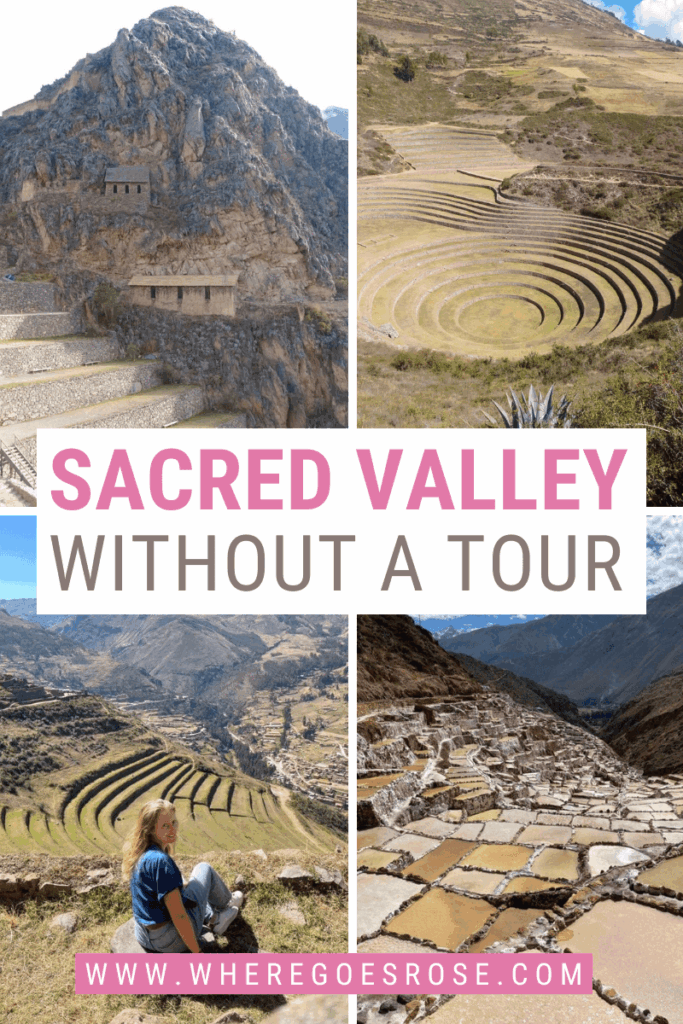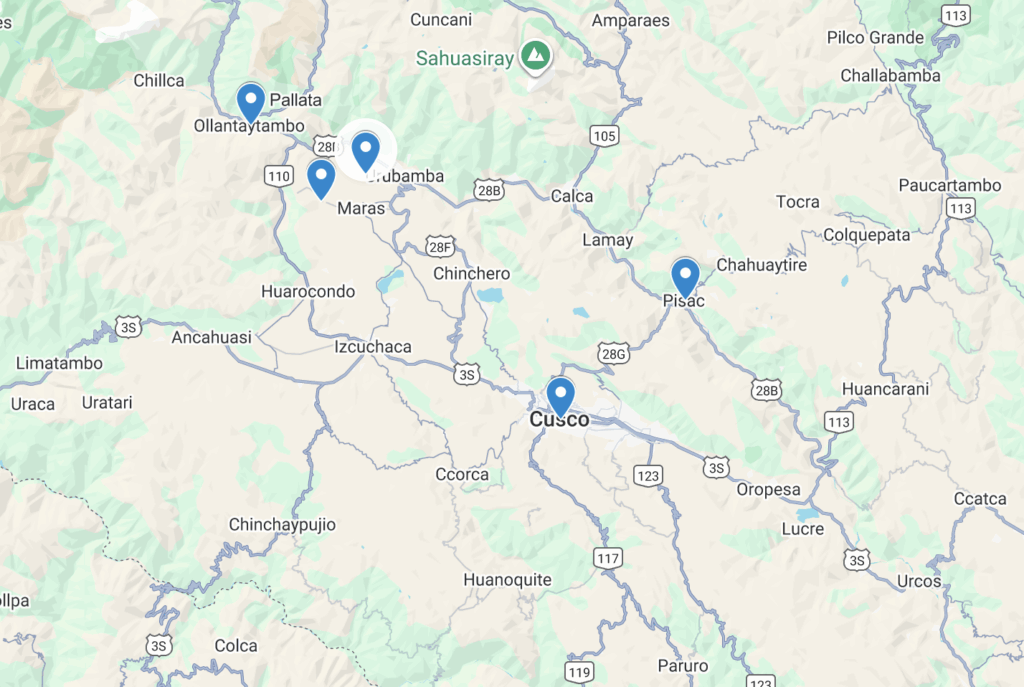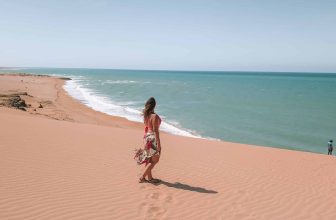
This post may contain affiliate links to things like tours, hotels, Amazon associates and products. These help me earn a small commission at no additional charge to you.
When I started researching how to visit the Sacred Valley attractions from Cusco, I was hit with a conundrum because I wanted to go without a tour.
Nothing sounded more like my idea of hell than a rushed day tour visiting with a thousand other people and being dragged away on a tight schedule, unable to explore them properly.
For starters, I wasn’t in a huge rush with six weeks in Peru, so I didn’t need to do that. Secondly, I just hate that style of tourism and prefer to do my own thing.
Since I was planning to hike the Salkantay Trail to Machu Picchu, I wasn’t looking to do much extra hiking as I wanted to save my energy.
Ideally, I wanted to do the Sacred Valley during day trips (I had the time to do this across multiple days) from Cusco without taking a tour. In this guide, I’ll help you do exactly that, using public transit.
What and where is the Sacred Valley?
It’s a region in Peru’s Andean Highlands. Stretching from the city of Cusco to the World Wonder of Machu Picchu, it was once the heart of the Inca Empire and remains full of ancient ruins and idyllic towns, dotted across the region.
Public transit in the Sacred Valley (or lack thereof)
Sadly, the public transport connections are limited. What you mostly find is ‘colectivos’: shared minivans mainly used by locals although tourists are welcome to hop in. I have many a time!
Colectivos usually leave when they’re full, so if you find yourself waiting for an empty one, know you probably just missed the previous one, and be prepared to wait 30 minutes for it to fill.
Expect to pay between 3 and 15 soles ($1-5) for colectivo rides within the Sacred Valley, depending on distance. The longest one I took was from Cusco to Ollantaytambo (the other side of the valley) which took around 1.5 hours.
On the downside, there are often no direct journeys available, meaning you’ll have to change vehicles in other towns which can be time-consuming.
Personally, I think those in charge of tourism in the Sacred Valley aren’t incentivised to improve the public transport because it’s more profitable when tourists take organised tours in the region. Doing it solo is certainly more of a battle, or shall we say an adventure, but worth it for independent travellers who want to avoid the crowds and take their time.
What are the main Sacred Valley sights?
Later in this guide, I’ll explain in detail how to reach these places and what to do there. But, for now, a quick introduction.
The top places are…
Ollantaytambo (ruins and town)

The small town of Ollantaytambo is surrounded by cliffs, many decorated with ancient Inca relics. This town has historic relevance as the last stronghold against the Spanish.
The ruins are right beside the town and easily visited by foot (although there are several stairs to climb). It’s very simple to visit this Sacred Valley site without a tour.
Pisac (ruins and town)

Another cute town with a mix of tourist-friendly cafes and authentic local markets (don’t miss the Sunday one) in the sunny central square. The ancient Inca ruins sit 500m above the town, requiring a taxi ride or a steep, exposed hike to reach.
It’s easy to visit from Cusco without a tour, as I’ll explain.
Moray Circular Terraces

Now an archaeological site, the impressive Moray Circular Terraces were once used for agriculture and highlight the advanced nature of the Incas. The levels created separate microclimates in which different food products could grow.
Items considered super foods today like quinoa, amaranth and purple corn were staples within Inca diets. Perhaps that’s what gave them the energy to build incredible structures like Machu Picchu!
Salt Mines of Maras
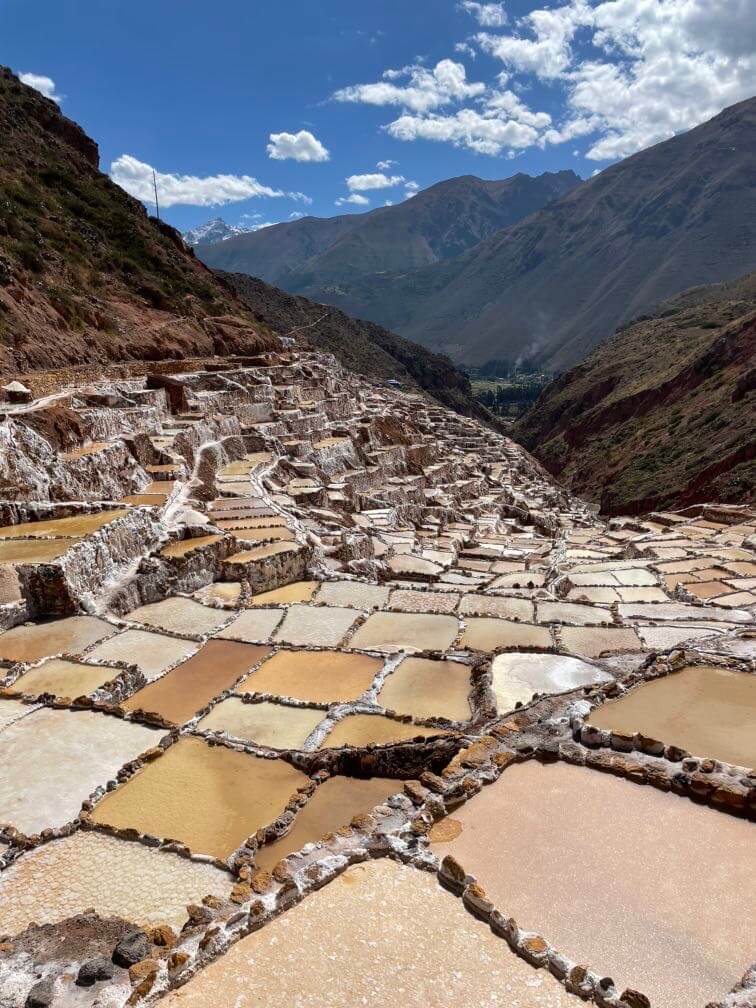
Used since Inca times, the Salt Mines of Maras still create livelihoods to this day. The endless sea of layered terraces stretches as far as the eye can see, the different coloured saline pools creating a patchwork of colours.
Local families own selected pools, and they can’t be bought or sold. The only way to acquire them is by marrying into the family that owns it.
The 500-year-old pans are man-made but the water source is natural. As it evaporates from the pools, it leaves behind salt crystals that are harvested and sold.
Entry is not included in the Tourist Ticket but only costs an extra 10 soles ($3).
To hike or not to hike?
Some people recommended hiking across the whole Sacred Valley, beginning in Ollantaytambo and arriving back in Cusco via a mix of hiking and colectivos.
This would be a 2-3 day trip and quite an intense one with early starts and long, exposed hikes in the heat. It’s certainly doable (and here are detailed instructions) but not exactly leisurely.
I chose to use Cusco as my base and explore the Sacred Valley attractions, splitting them across multiple days without any hiking. Keep reading if that’s what you’re after, too.
Archeological tickets for the Sacred Valley
The Cusco Tourist Ticket (BTC) is a pass allowing you to visit the main attractions. It’s confusing with ‘circuits’ valid for differing amounts of time and including different attractions.
Circuits I and II are for attractions nearer to Cusco (such as Sacsayhuaman), but what you want is Circuit III (Sacred Valley Ticket).
Option #1 – Partial Ticket valid for two days including Pisac, Ollantaytambo, Moray and Chinchero. The price is 70 soles ($20).
Problem with this option – if you choose to visit the Sacred Valley without a tour relying on public transport, you can’t realistically make it to Pisac, Ollantaytambo and Moray in two days. You could in three days but such a pass doesn’t exist, the next option up is…
Option #2: Full Ticket valid for 10 days and including Pisac, Ollantaytambo, Moray, Chinchero AND 12 other sights (including museums and archaeological sights near Cusco). The price is 130 soles ($36); obviously the best value option.
How to buy the pass
Buy it at the first attraction you visit, in cash. It will activate including that day in the total number of days’ validity (2 days or 10 days depending whether you buy the Partial or Full ticket).
They may ask for your passport so remember to bring it with you.
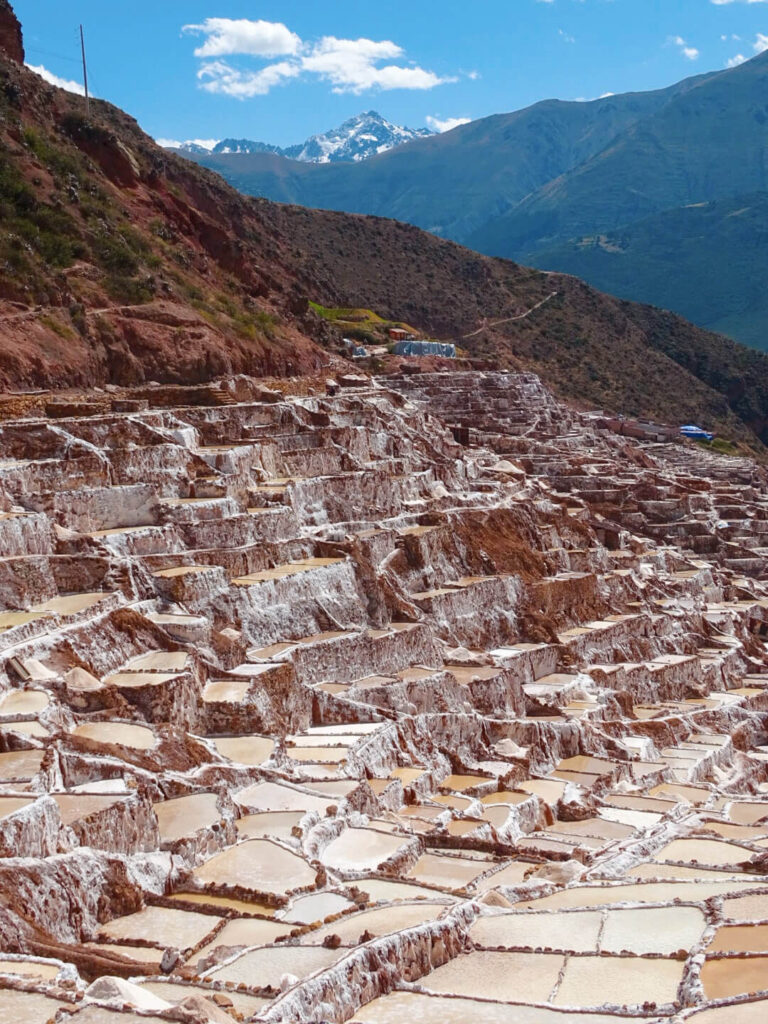
Visiting the Scared Valley sights without a tour
Here’s a breakdown of what’s to come, followed by more details about each place.
- Ollantaytambo – day trip (or stay overnight) by mini bus from Cusco
- Pisac – day trip (or stay overnight) by mini bus from Cusco
- Maras and Moray – the tricky bit! Take a colectivo destined for Urubamba and hike 30 minutes to Maras, then hike 4.5km between Maras and Moray. Take colectivos home via Chinchero. The other option is a tour that visits these two attractions only (rather than ALL the Sacred Valley stops). More details to come.
Visiting Ollantaytambo in the Sacrey Valley without a tour
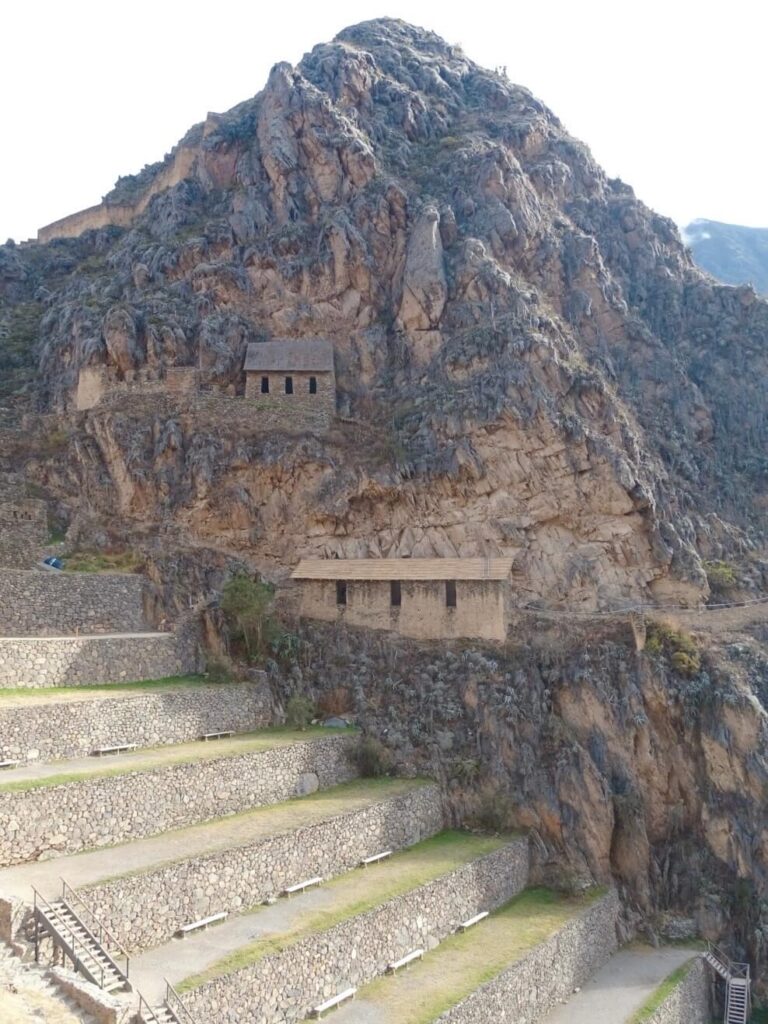
This was my favorite Sacred Valley town apart from perhaps Pisac. Although they both have a similar vibe – small towns with Inca ruins that are well equipped for tourism with cute cafes etc – I found Ollantayambo more authentic without so many foreigners living there (more on that when we discuss Pisac).
The Ollantaytambo ruins are the most famous thing to do here (and also the easiest Inca ruins to visit in the Sacred Valley because they are on ground level by the town, rather than up a steep hill like in Pisac).
Organised day tours will only allow time for the ruins before rushing you out of town. If you stay for a whole day or overnight, there are several other things to do in Ollantaytambo, most of which are free.
How to visit Ollantaytambo as a day trip from Cusco: This one is easy. Regular colectivos take around 1.5 hours. Set off early to avoid exploring them in the hot midday sun. They depart from Calle Pavitos in Cusco.
To return from Ollaytaytambo, take a colectivo from the main square outside Valentino’s Cafe. Expect to pay around 15 soles each way.
What about staying overnight? I chose to stay overnight in Ollantaytambo which I think was a good idea. I visited the ruins at 7am and had them to myself, then went inside to chill when all the tour groups were visiting. In the late afternoon and evening, I had the town to myself again.
For a homey place to stay with a local family, I suggest Casa Inka B&B for $30 a night.
How to combine with visiting Machu Picchu?
Ollantaytambo is where the train to Machu Picchu arrives and departs (the train station is a 20-minute walk from the centre of town). After visiting Machu Picchu, most companies will collect you from the train station via minibus headed back to Cusco, meaning you won’t see Ollantaytambo while transiting.
Since I wanted to visit this Sacred Valley attraction without a tour, I decided the easiest option was to tell my trekking company I didn’t need the minibus back to Cusco, and stay in Ollantaytambo overnight. I ended up staying a couple of nights as I was tired after trekking, but I’d say one is enough.
Ollantaytambo ruins

Built by Emperor Pachacuti in the 15th century to conquer local tribes, this site became historically important as the last stronghold against the Spanish. They were even defeated once here by the Incas, but sadly, they managed to conquer most of Peru and South America eventually.
Entry to the Ollantaytambo archaeological site is included in your Tourist Ticket mentioned above. If it’s the first site you’re visiting, buy your ticket in cash at the entry desk.
The ruins are right beside the town and visible from wherever you are. You can’t miss them!
After climbing the main stairs, you’ll reach the famous Sun Gate and the Temple of the Sun. The views down over the town are beautiful, and you may be lucky to see lots of alpacas in the grounds like I did.
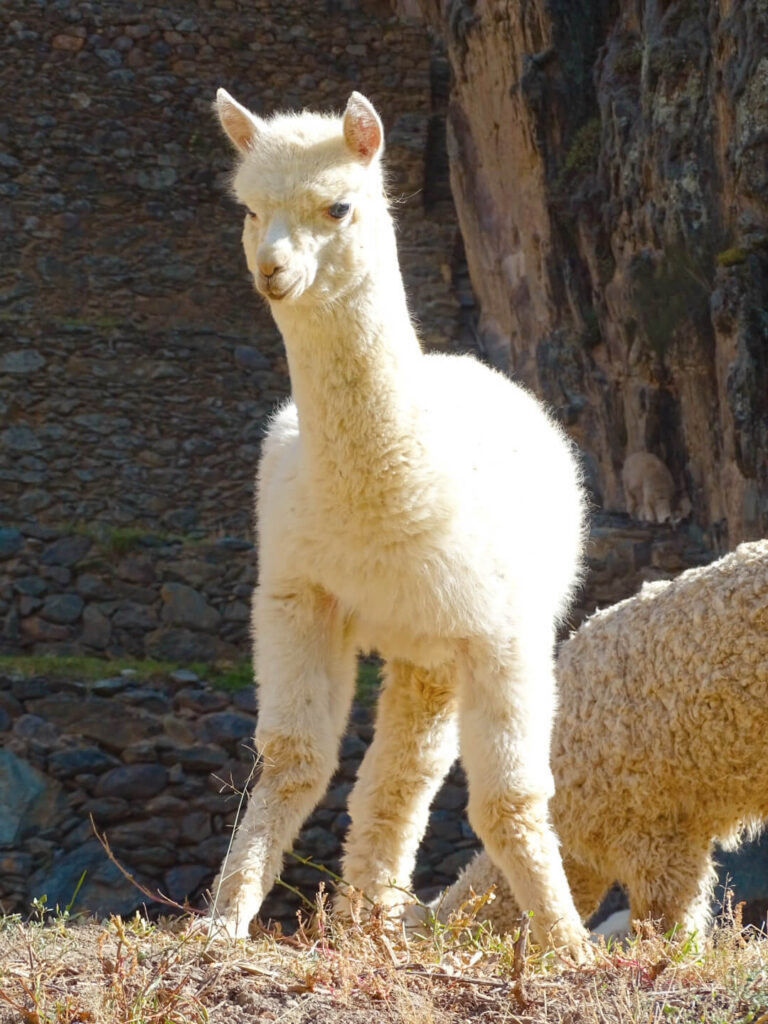
Do you need a guide? It will never hurt to learn more about the history and context of this fascinating place. However, the site is smaller than the Pisac ruins so, if you only hire one, I suggest doing it there instead.
Opening times: 7am to 5pm. Go early or late if possible. Not only is it crowded when the groups arrive, but it’s also hot and exposed in the middle of the day without any shade.
What else to do in Ollantaytambo
- Wander the cute cobbled alleyways of the Inca town, stopping at shops and cafes
- Hike up to Pinkuylluna ruins (free entry) at the east and west ends of the town, built into the cliff faces. These were Inca storehouses built to store grains and the like
- Visit other Inca ruins like Quellorakay, Punku Punku and Inka Pintaya, all free and within a 15-minute walk from town
- Visit museums and galleries – learn and eat at the ChocoMuseum, and browse art (and enjoy the garden cafe) at ALQA.
Where to eat in Ollantaytambo
- Latente Specialty Coffee – the coffee is excellent but the highlight was the kimchi cheese toastie. As a kimchi superfan, I was so happy to find some.
- Cuchara Llena – a cosy vegetarian restaurant where I had a homecooked meal
- ALQA – visit the fancy restaurant within the museum complex. I didn’t eat a full meal, just an orange and cacao tea and a dessert in the beautiful gardens.
- By the main square, Restaurant Qori illari and Saqra are both cosy, family-run restaurants where you can tuck into traditional Peruvian food and the odd bit of Western food, too.
- Nina del Valle – hearty, upscale Peruvian food with fresh fish and Pisco sours cocktails. Plenty for vegetarians.
- El Abra – toward the train station, this is a cool cafe for brunch and coffee. I loved the avo toast with scrambled eggs.
- Sunshine Cafe – beside the ruins, this is where to come for breakfast, sandwiches, coffee and cakes.
Visiting Pisac from Cusco as a day trip without a tour
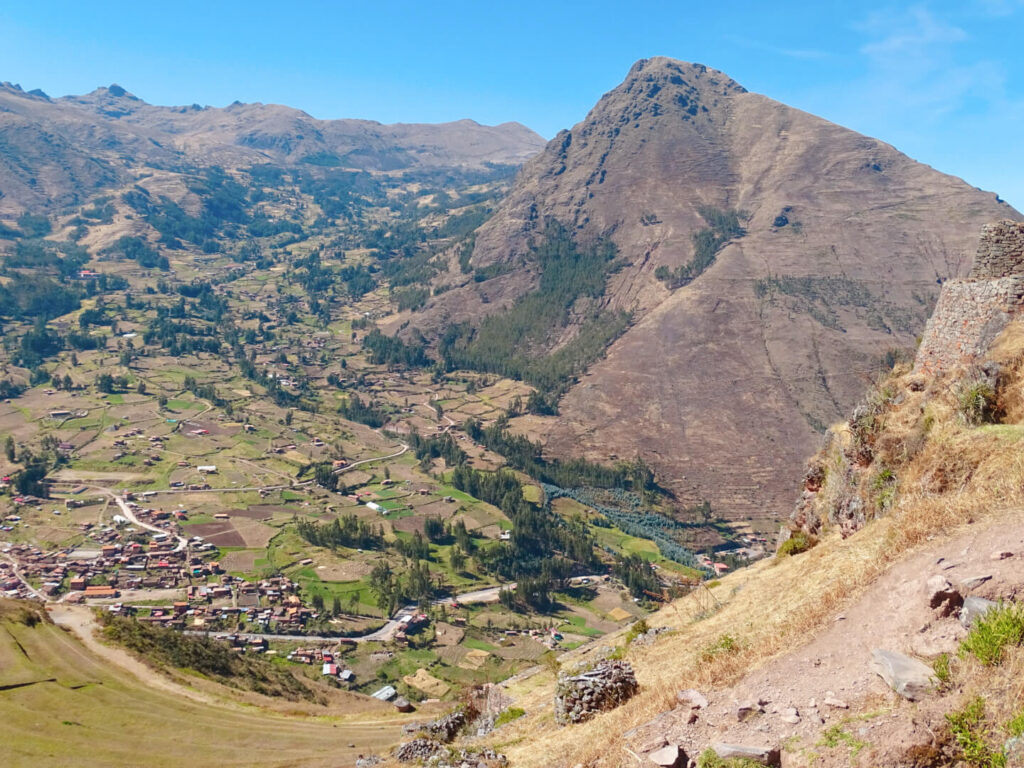
Pisac is an idyllic Inca town known for its weekly Sunday market. Stands selling everything from colourful fruit to fresh, ready-to-drink coconuts sprawl across the central square. It doesn’t feel like a touristy market, however there are several craft markets in town where you can buy all the rugs and llama keyrings your heart desires!
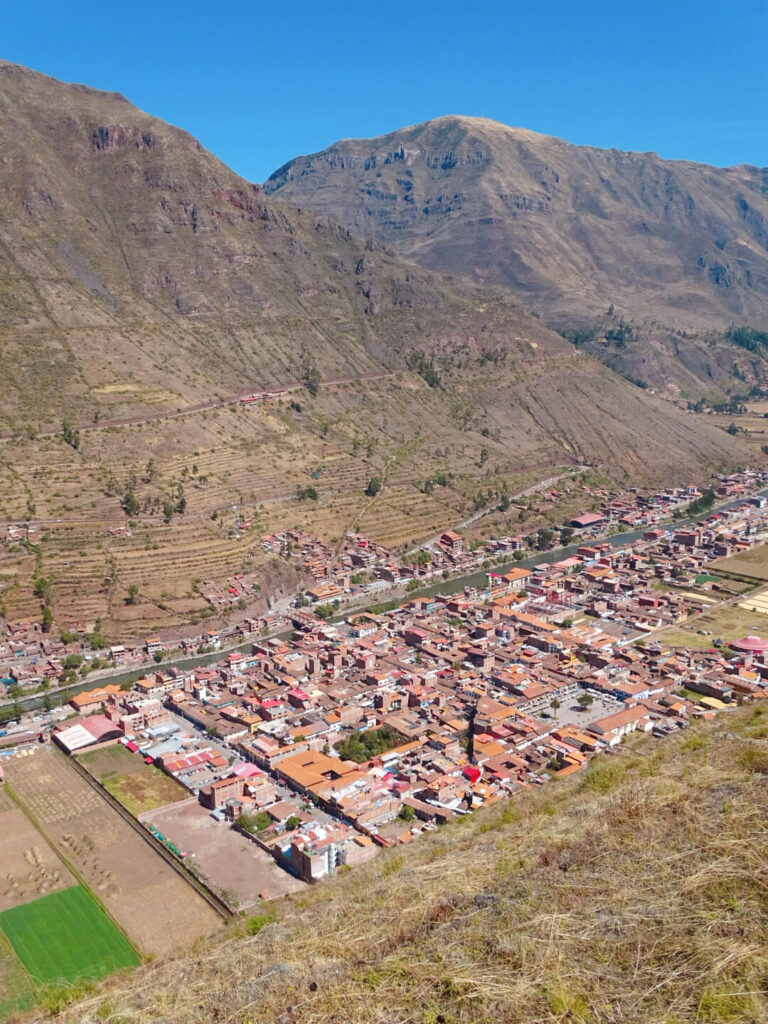

I had heard before visiting that Pisac was ‘spiritual’ and decided that had one of two possible meanings: it was full of authentic holistic practices passed through generations of local people… OR pretentious foreigners had taken over.
It was the latter, reminding me of San Marcos in Guatemala. You can try everything from sound healing to yoga and even ayahuasca, but the workshops are mostly run by foreigners from wealthy countries, not supporting local infrastructure. Many of the activities are more global, holistic trends rather than unique to Peru or even South America.
Getting to Pisac from Cusco by public transport
To visit this stunning place in the Sacred Valley without a tour, board a colectivo from Calle Puputi on the edge of Cusco. The journey takes around 45 minutes and vans leave when full. Expect to pay around 7 soles each way.
Visiting Pisac ruins
Instead of walking two minutes to the ruins like in Ollantaytambo, you can take a taxi or embark on an uphill climb. The ruins sit overlooking the town at 3,350 meters above sea level.
I decided to take a taxi up and walk down.
Pisac ruins are included in your Touristic Ticket (mentioned at the top of this article).
I found the site to be larger than Ollantaytambo and a guide is highly recommended to learn about it all. However, as I was travelling solo, I couldn’t justify the cost and ended up doing my own research later.
Opening times: 7am to 5pm.
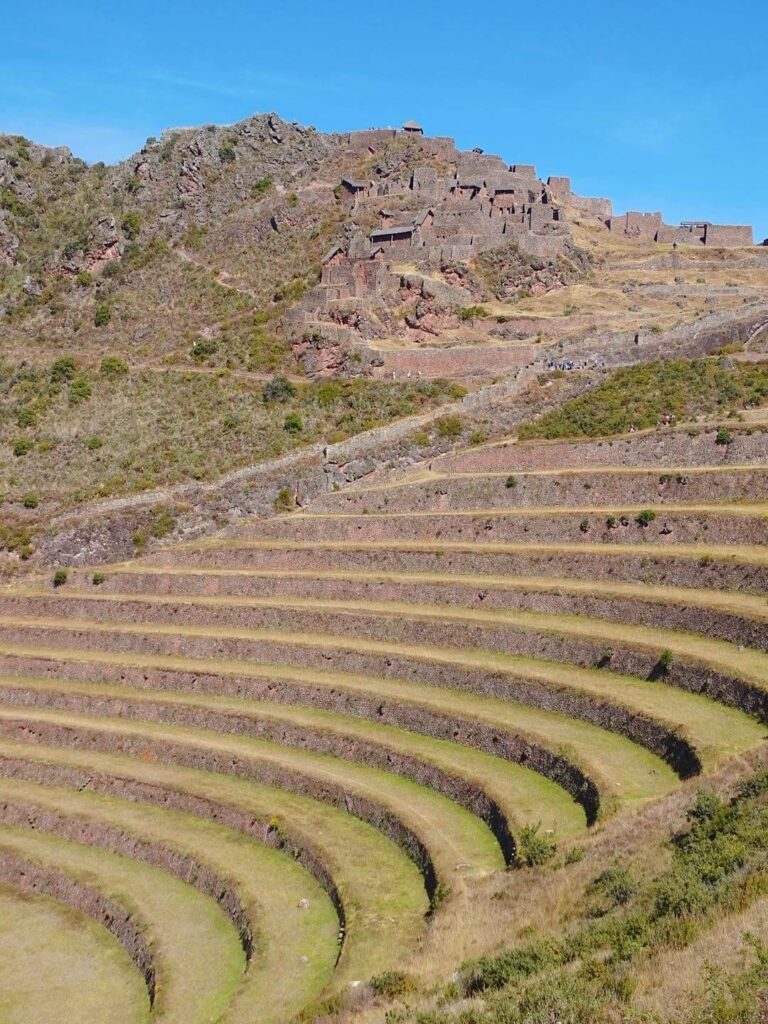
An advantage of staying overnight is visiting early before the groups arrive.
I got there by 10am after taking a colectivo from Cusco and was dismayed to find the place packed. From looking at the itineraries of day trips that visit the whole Sacred Valley in one day, I had deduced that groups visit in the afternoons. However, I think there are so many different types of tours that it just can’t be avoided.
Give yourself 1-2 hours to explore the site, and another 30 minutes to hike back down to town.
Getting from Pisac to the ruins by taxi
I organised one from where the colectivo from Cusco dropped me. As they’re official tourist cabs, the price doesn’t change much: I paid 25 soles ($8). My driver must have been 90 years old. Quite the experience up very dusty, sandy roads!
If you haven’t yet bought your Tourist Ticket, tell your driver who will stop at the ticket office. The entry is five minutes further on, so stay in the car if you already have your ticket.
Getting from Pisac to the ruins by hiking
Find an entry gate on ground level, a few streets back from the town. I’ve pinned it here. It’s a steep uphill hike that should take around 1-1.5 hours.
To hike down, simply head towards the back of the site and hike with the sweeping landscape on your left, passing layered terraces. The trail is pretty easy to follow, and you’ll soon see Pisac town in sight. It’s much quicker going down than up, obviously. I think it took me between 30 and 45 minutes.
What else to do in Pisac
- Shop at artisanal markets – there are plenty selling stunning woven goods. A little bit of haggling may be accepted if you buy multiple items, but perhaps don’t haggle too hard when this is a livelihood for many hardworking locals.
- Hike to Laguna Kinsa Cocha – I heard good things about the hike at this nearby lake.
- Eat at all the vegan restaurants and indulge at the coffee shops – I had a delicious lunch at Mamacocha (below left) and coffee at a chocolate croissant at Mama Mamita (below right)
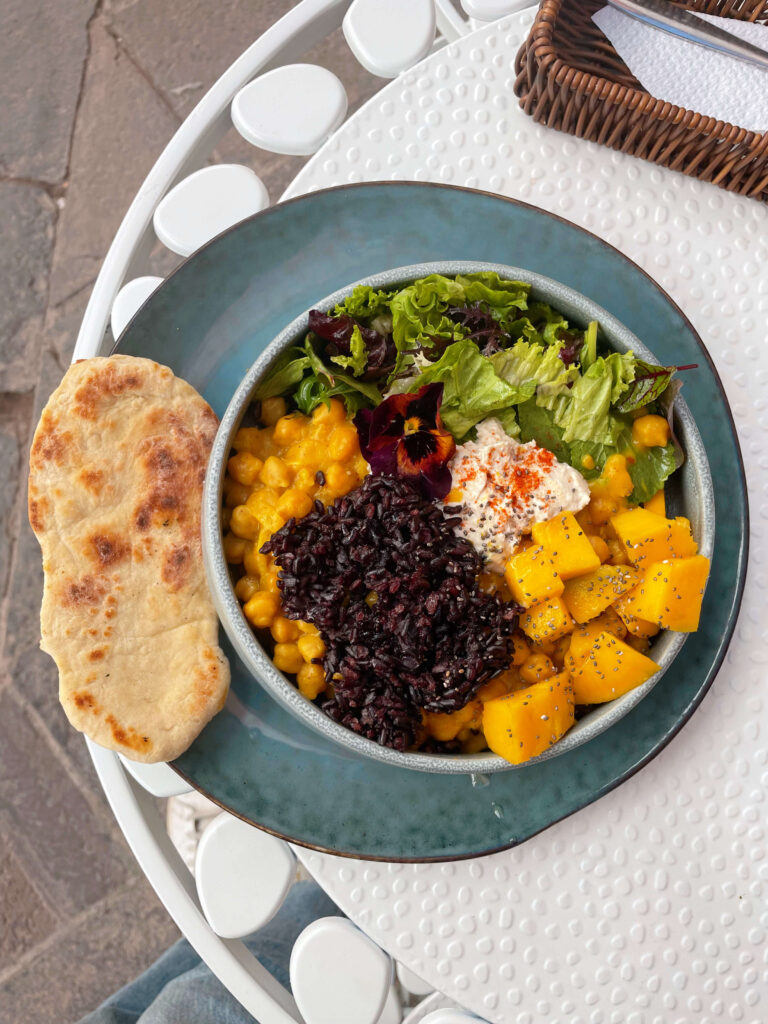
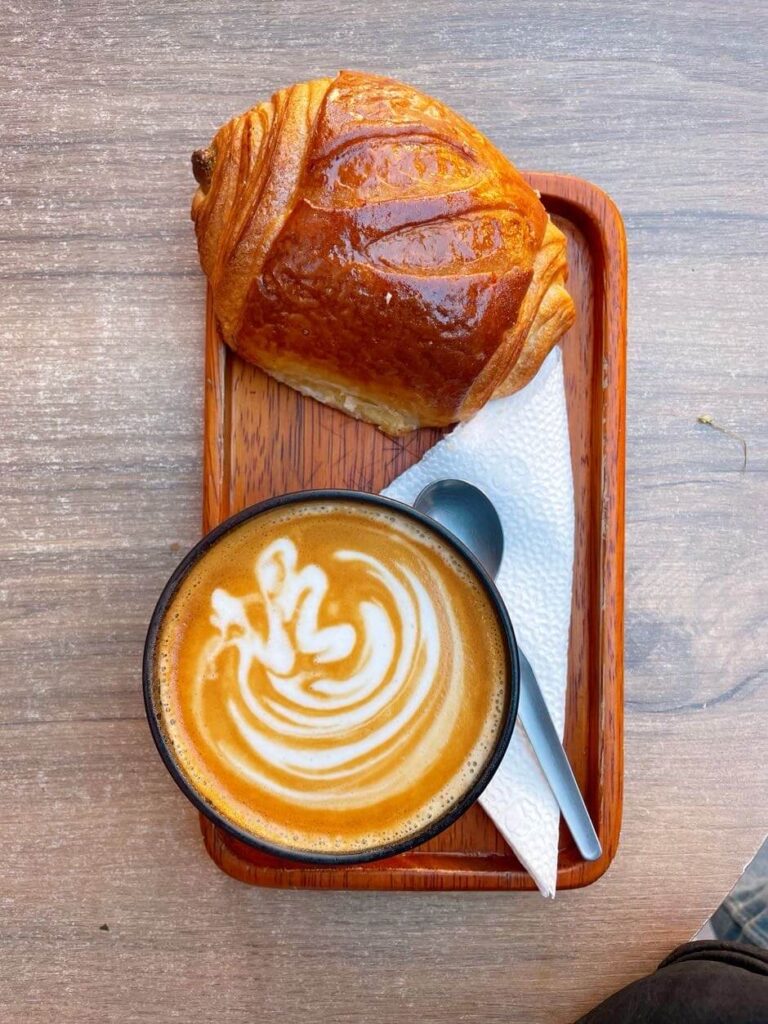
Visiting Moray and Maras as a day trip from Cusco without a tour
This is where it gets tricky! I was scouring the internet for ways to visit Moray and Maras by public transport but sadly there aren’t direct buses.
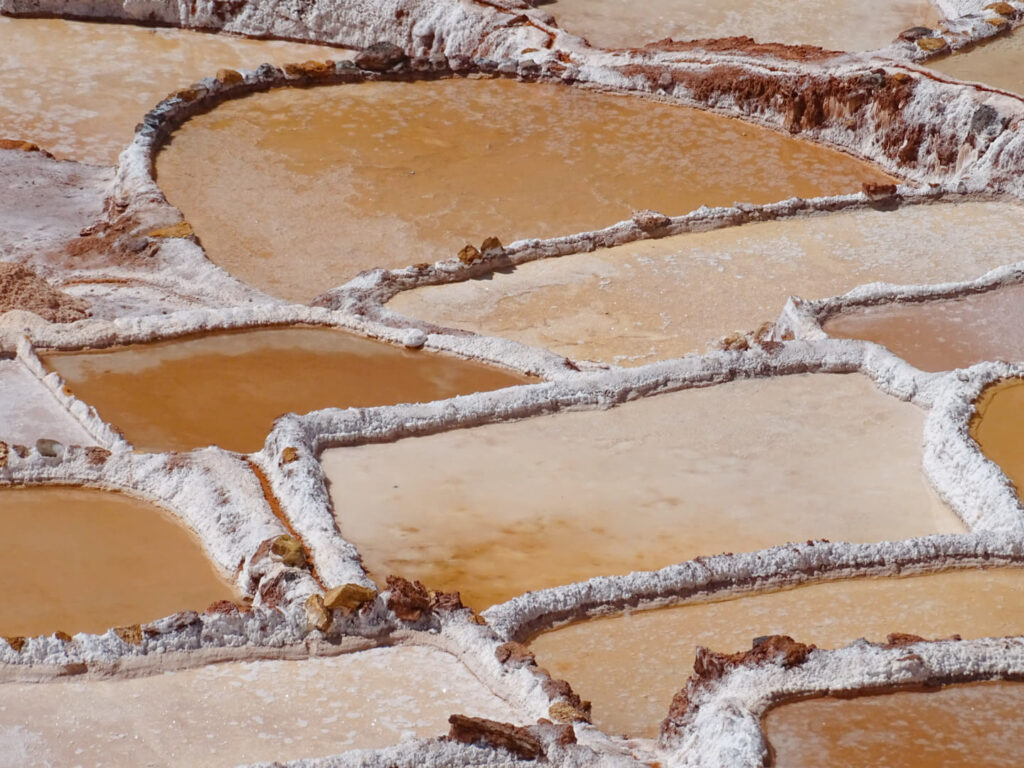
In the end, I decided to take a day tour not to ALL the Sacred Valley attractions but just these two. I was feeling tired from a food poisoning contracted in the Amazon and only had two days until my 5-day Salkantay hike so I wanted to preserve all the energy possible.
I was hoping this day tour would spread Moray and Maras across the whole day, meaning less rushing… but sadly not! We whizzed between the two attractions at the same time as endless other tour buses (without time to properly appreciate the places) and spent the rest of the day at forced shopping shops.
Overall, I hated it.
Still, you feel it’s the best option given the lack of transport between Cusco, Moray and Maras, especially if you’re a solo female traveller in Peru and hesitant about hiking and navigating local transport alone.
If so, it’s this tour with MP Reservations. But know what you’re letting yourself in for.
If I had been in a better situation, health and energy-wise, here’s what I have researched since and would do instead…

Colectivo / hiking expedition to Moray, Maras and Chinchero
Step #1: Find a minibus (colectivo) travelling from Pavitos Street in Cusco bound for Urubamba. Tell the driver you want to get off close to Maras Salt Mines (in Spanish, say ‘Salineras de Maras’ or show a photo). The journey should take 1.5 hours and cost around 6 soles.
Step #2: Hike for 30 minutes to the Salt Mine. Entry is not included with the Sacred Valley ticket so pay 10 soles ($3) in cash.
Step #3: After visiting Maras, take a 4.5-kilometer hike to Moray Circular Terraces. Alternatively, get a taxi the 30-minute drive.

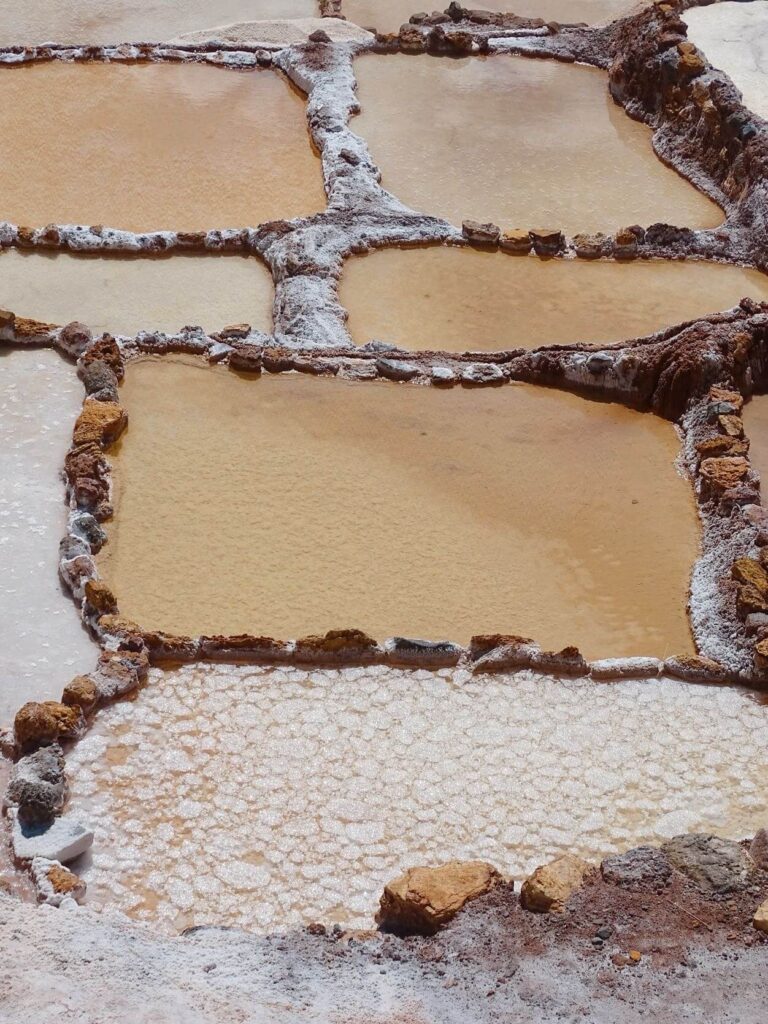
Step #4: outside Moray on the main road, wait for a colectivo destined for Ramal (20 minutes) then switch to one for Chincero (also 20 minutes). Here you can visit Chincero Ruins (included in your Tourist Ticket), shop at the textile market or, if you’re feeling done for the day, simply board another colectivo (45 minutes) back to Cusco.
Yes, this day out is complicated with plenty of hiking and four colectivos in total. But it may be worth it to see the Sacred Valley without a tour! Set out early (Maras Salt Mines opens from 8am and it takes two hours to get there by bus and hike). Check when you arrive in Chinchero what time the last bus to Cusco departs.
Cost: The first colectivo should cost 6 soles and I anticipate the others will be under 5 soles each. The whole day’s transport should cost around 25 soles (under $8). The Salt Mine entry is 10 soles and the other attractions are included in your Tourist Ticket.
If you opt for a taxi between Moray and Maras, you may not save any money on the price of the day tour I took ($15) but I feel you WILL have a more authentic and less crowded experience.
Tips: Wear comfy shoes, a hat, sunglasses and sunscreen, and pack snacks and water (you can buy it at Moray and Maras but it will be overpriced). Chinchero will be your best bet to have a proper meal. Ask locals for directions when hiking; they’re a friendly bunch.
Read this guide for more details of this exact trip.
Thanks for reading!
Read more Peru blogs:
